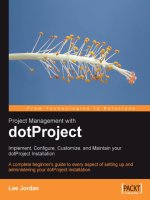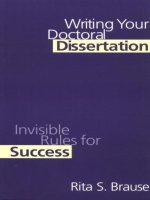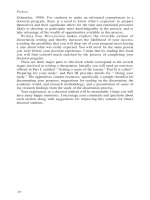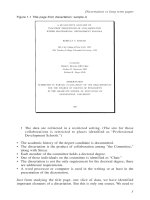Writing and Presenting your Professional Dissertation - MBA
Bạn đang xem bản rút gọn của tài liệu. Xem và tải ngay bản đầy đủ của tài liệu tại đây (187.36 KB, 27 trang )
Writing and presenting your Professional Dissertation – November 2011 1
1
1
MBA PROGRAM
WRITING AND PRESENTING
YOUR PROFESSIONAL DISSERTATION
November 2011
2
2
AGENDA
The Objectives of the Professional Dissertation
The Role of the Tutor
The Different Phases of the Dissertation Implementation
The Problem Statement and the Research methodology
The Copies to submit
The Structure and the Content of the Dissertation
The Format of the Dissertation
The Dissertation Defense
Writing and presenting your Professional Dissertation – November 2011 2
3
3
THE PROFESSIONAL
DISSERTATION
Is the key element in the MBA student’s
schooling;
Shows the quality of the research carried
out by the student, depending on:
Intensity of his/her work;
The riguour of the analysis;
How carefully the structure and the form have
been made.
4
4
THE OBJECTIVES OF THE
DISSERTATION
The Dissertation meets two main objectives:
To put into practice the academic knowledge
you acquired at the CFVG and to deepen it as
you are implementing the research.
To learn a working methodology: time
management for a long-term work, research and
production of information with a critical acumen,
documentation and collection of data focused on
a specific problem.
Writing and presenting your Professional Dissertation – November 2011 3
5
5
THE DISSERTATION CONCEPT
A good dissertation will make a meaningful contribution
to the field, but with fairly specific or narrow topic
area.
A dissertation is not a corporate report or an internship
report.
A dissertation should:
Summarize and integrate pertinent research and theory in
its topics area.
Make a contribution of knowledge to its topic. This can be
accomplished in several ways, such as conceptualizing an
issue or problem in a useful manner, collecting new data
through quantitative or qualitative research, demonstrating
the applicability of a research method.
Show how a topic is analyzed.
6
6
THE ROLE OF THE TUTOR
The tutor, who was chosen for his expertise related to the topic of the
Dissertation,
Guides the student in his research and helps him getting useful
contacts.
Contributes both to the content and to the form.
Gives grades to the three written copies the student has to submit. His
written evaluation on the Final Copy of the Dissertation is necessary to
allow the student to defend his/her Dissertation with the presence of a
Board of Examiners.
Takes part in the Board of Examiners who attributes the grade of the
defense.
Writing and presenting your Professional Dissertation – November 2011 4
7
7
THE ROLE OF THE TUTOR (2)
The student has to contact his/her Tutor frequently in
order to have the feedback on the quality of the
Dissertation. A calendar of meetings is necessary to help
the student respect the main deadlines of the
Dissertation and avoid to modify his/her paper in the last
minute.
The Tutor may also suggest the student to narrow down
the scope of the research to make the Dissertation more
workable.
The most successful supervisor-student relationships are
those in which the interaction of research and learning is
two-way, in which the student discovers and explores
materials and insights which are stimulating to the
supervisor as well.
8
8
THE DIFFERENT PHASES OF THE
DISSERTATION IMPLEMENTATION
- Defense before a jury (Session 2)1 to 31 Oct 2012
- Submit the “Final Copy” (Session 2)
Monday, 17 Sept 2012
- Defense before a jury (Session 1)2 to 13 July 2012
- Submit the “Final Copy” (Session 1)
Monday, 18 June 2012
- Oral presentation of the “Intermediate Copy” with the tutor
16 to 27 April 2012
- First handling of the information
- Research and analysis of the information
- Submit the “Intermediate Copy”
Monday, 9 April 2011
- Definition of the major points of the problem statement
- Submit the paper of the “Proposal of the
research topic”
Monday, 13 Feb 2012
- First contact with tutor19 to 26 Dec 2011
- Final choice of the topicFriday, 16 Dec 2011
- Submission of Registration Form to the Secretary’s office
Monday, 28 Nov 2011
- Introduction to the Professional Dissertation and Distribution
of Registration Form
Tuesday, 15 Nov 2011
Writing and presenting your Professional Dissertation – November 2011 5
9
9
THE FINAL GRADE
20TOTAL
10
4
4
2-13 July 2012
Or
1-31 October 2012
Dissertation Defense
• Written report
• Oral presentation
• Answers to questions
5
Accepted or not18 June 2012
Or
17 September 2012
Final Copy4
2
(Accepted or not)
16-27 April 2012First Oral Presentation 3
Accepted or not9 April 2012Intermediate Copy2
Accepted or not13 February 2012Proposal of the
Research Topic
1
WeightDeadlineEventsPha
ses
10
10
WRITING MBA DISSERTATION
The first thing to do is to identify a topic
Where do topics come from?
Can you brainstorm about research topics?
What is your topic about?
Why does it matter?
Writing and presenting your Professional Dissertation – November 2011 6
11
11
HOW TO GET STARTED?
Start with the existing literature (identify a gap;
potential for extension or replication)
Start with a theory
Start with a new industry phenomenon or a recent
issue (current issues, news, etc.)
Start with local issues
Ask yourself three questions:
Does it make sense?
Does it matter?
Can you (already) find the question in the literature or can you
answer it through research?
12
12
STATE YOUR PURPOSE
The paper adds conceptually to the current body
of knowledge
It exposes a weakness in the current body of
knowledge
It tests a new proposition and demonstrates a
new way of applying the body of knowledge
It adds empirically to the body of knowledge
with new empirical evidence
Writing and presenting your Professional Dissertation – November 2011 7
13
13
"THE CRITICAL DIAMOND"
YOU
Your Field
Your Subject
Your Portfolio
14
14
THE PROBLEM STATEMENT
The problem statement of a research dissertation indicates the
problem that the researcher aims at his work. From this problem
statement, the student will come up with the main question of his
research: What will be studied in my work?
A problem statement must have a wide view, but on a field of very
precise application.
A problem statement must not be limited to a description or a report
of situation. It is compulsory to analyze the information you have
with a critical acumen.
In a research work, you have to show the clear problem from the
beginning and to justify it.
Writing and presenting your Professional Dissertation – November 2011 8
15
15
THE RESEARCH METHODOLOGY
The methodology includes the methods
used to
solve the problem mentioned in the problem
statement.
reach the objectives of the research.
Making the methodology clear allows to
assess the analysis and results with clear
references.
16
16
COPIES TO BE SUBMITTED:
THE PROPOSAL OF THE RESEARCH TOPIC
As for the form, the proposal will include:
A. The title (the most specific possible).
B. The objectives of the research:
- Introduction of the topic,
- Problem statement,
- Rationale of the research
- The working hypothesis of the research, (if already elaborated).
C. The scope and limitation of research study (what it includes and what it does
not include)
D. The position of the research compared to the available knowledge and former
works.
E. The relevance of the research.
F. The possible identification of specific problems and extra hypotheses that will be
needed.
G. The research methodology: selected methods to solve the problem must be
indicated with precise tasks and a possible schedule
H. The sources of information: the bibliography and other sources of information.
The proposal has to be no more than five pages long.
Writing and presenting your Professional Dissertation – November 2011 9
17
17
COPIES TO BE SUBMITTED:
THE INTERMEDIATE COPY
It must include:
A. The definitive title of the Dissertation.
B. An introduction of the topic, with precise instructions about the problem
statement and the methods used to solve it. Concerning primary
information, the means for collecting data, the kinds of information
providers, the making of guide-books of interviews and questionnaires must
be specified. For secondary information, the sources of information must be
mentioned.
C. All these chapters, parts, sub-parts of the work should be academically
included. For each chapter and part, if you are not able to provide the final
essay, you will briefly quote the main ideas which will be developed.
D. The provisional conclusions, according to the results of analysis obtained at
this stage.
E. The bibliography.
F. The appendices.
18
18
The student has to present the Intermediate
Copy to his/her Tutor.
The objective is to show that the student makes
progress in his/her research as planned and that
he/she will be able to meet the deadline.
In order to present an overview of the research
at this step, the student will have to provide a
sufficient effort to quickly get information and to
analyze it.
THE FIRST ORAL PRESENTATION
Writing and presenting your Professional Dissertation – November 2011 10
19
19
COPIES TO BE SUBMITTED:
THE FINAL COPY
The final copy will present all of your research results. It must include the following
parts:
A. The standard cover page (same presentation as in the Consultancy Project
Report), the notification page.
B. The table of contents with numbered pages.
C. The list of charts, graphs presented in the copy, page numbering. A list of
acronyms, abbreviations in the copy must also be added.
D. Information on the company or on the environment the topic is about.
E. The introduction of the Dissertation, with the problem statement and
methodological instructions.
F. The different parts of the Dissertation.
G. The conclusion is composed of a brief summary of the obtained results, a short
thinking about these results, and the possible extensions of the undertaken
research.
H. The bibliography.
I. The table of contents of the appendixes (the page numbering of the appendixes
follows the one in the Dissertation).
J. The appendices.
K. Glossaries and index if needed.
20
20
STRUCTURE OF THE
DISSERTATION
Introduction
Chapter I: Theoretical framework or Literature
review
Chapter II: Methodology
Chapter III: Findings and Results Analysis
Chapter IV: Recommendations
Conclusion
Bibliography
Appendices
Writing and presenting your Professional Dissertation – November 2011 11
21
21
THE INTRODUCTION
OF THE DISSERTATION (1)
Components of the Introduction of the Dissertation :
Background
Rationale of the Research
Problem Statement
Research Objectives
Scope of the Research
Previous research works
Limitations
Assumptions
Methodology of the Research
Structure of the Dissertation
22
22
THE INTRODUCTION
OF THE DISSERTATION (2)
Purpose : The Introduction section aims at answering the following
questions:
1. What is the context of this problem? In what situation or
environment can this problem be observed? (Background)
2. Why is this research important? Why do we need to know this?
Why does this situation, method, model or piece of equipment
need to be improved? (Rationale of the research)
3. What is it we do not know? What is the gap in our knowledge this
research will fill? What needs to be improved? (Problem
Statement)
4. What steps will the research take to try and fill this gap or
improve the situation? (Objectives of the Research)
Writing and presenting your Professional Dissertation – November 2011 12
23
23
5. Is there any aspect of the problem the research will not discuss?
Is the study limited to a specific geographical area or to only
certain aspects of the situation? (Scope of the Research)
6. The position of the research compared to the available
knowledge and former works (Previous research works)
7. Is there any factor, condition or circumstance that prevents the
researcher from achieving all his/her objectives? (Limitations)
8. In considering his/her method, model, formulation or approach,
does the researcher take certain conditions, states, requirements
for granted? Are there certain fundamental conditions or states
the researcher takes to be true? (Assumptions)
THE INTRODUCTION
OF THE DISSERTATION (3)
24
24
Common problems:
Too much details, and too long
Repetition of words, phrases or ideas
Unclear problem definition
Poor organization
THE INTRODUCTION
OF THE DISSERTATION (4)
Writing and presenting your Professional Dissertation – November 2011 13
25
25
LITERATURE REVIEW (1)
The purpose: it should answer to the following questions:
1. What do we already know in the immediate area concerned?
2. What are the characteristics of the key concepts or the main factors
or variables?
3. What are the relationships between these key concepts, factors or
variables?
4. What are the existing theories?
5. What are the inconsistencies or other shortcomings in our
knowledge and understanding?
6. What views need to be (further) tested?
7. What evidence is lacking, inconclusive, contradictory or too limited?
8. Why study (further) the research problem?
9. What contribution can the present study be expected to make?
10. What research design or methods seem unsatisfactory?
26
26
To write a good Literature Review:
Read with a purpose: emphasizing which ideas
or information important to your research;
looking for the major concepts, conclusions,
theories, arguments, etc. that underlie the work,
and similarities and differences with closely
related work.
Write with a purpose: aims to evaluate and show
the relationships between the work already done
and between this work and
your own.
LITERATURE REVIEW (2)
Writing and presenting your Professional Dissertation – November 2011 14
27
27
LITERATURE REVIEW (3)
Common problems:
Trying to read everything
Reading but not writing
Not keeping biobliographic information
Not relevant to the topic
Using only one textbook
Try to copy and past theories from
textbooks and Internet
28
28
METHODOLOGY (1)
Purpose:
The method section aims to show your
reader how you obtained your results.
It answers to the questions:
1. What is your research design? Introduce the
plan outlining the investigation to be carried out
once the research problem/question have been
defined.
2. How was the data collected or generated?
3. How was it analyzed?
Writing and presenting your Professional Dissertation – November 2011 15
29
29
METHODOLOGY (2)
Why do we need to explain the method?
The method affects the results.
Often there are different methods that we can use to
investigate a research problem.
The reader wants to know that the data was collected or
generated in a way that is consistent with accepted practice
in the field of the study.
The research method must be appropriate to the objectives
of the study.
The method should also discuss the problems that were
anticipated and explain the steps taken to prevent them
from occuring.
It is useful in some cases for other researchers to replicate
your methods.
30
30
METHODOLOGY (3)
Common problems:
Irrelevant details
Unecessary explanation of basic procedures: notice
that the readers will be people who have a level of
expertise in the field.
Problem of blindness: ignore significant problems or
pretend they did not occur. But instead, recording
how you overcame obstacles that you encounter
when collecting or generating data can form an
interesting part of the method. It means you can
also give a rationale for certain decisions, plus a
realistic view of using the methods you chose.
Writing and presenting your Professional Dissertation – November 2011 16
31
31
RESULTS (1)
Purpose: to present the results and make them
meaningful to the reader. It includes:
Statement of results: the results are presented in a
format that is accessible to the reader (e.g. in a graph,
table, diagram or written text). Raw data is usually put
in an appendix.
Explanatory text: all graphs, tables, diagrams and
figures should be accompanied by text that guides the
reader’s attention to significant results. The text makes
the results meaningful by pointing out the most
important results, highlighting significant trends or
relationships, and commenting on whether certain
results were expected or unexpected.
32
32
RESULTS (2)
Organization
The method of organization depends on the
quantity and type of results you obtain from
your research.
There are two ways of organizing the results:
Presenting all the results, then giving a discussion
(in a different section).
Presenting part of the results then giving a
discussion, presenting another part then give a
discussion, etc.
Writing and presenting your Professional Dissertation – November 2011 17
33
33
RESULTS (3)
Common problem
Text includes too much details that simply repeat
data presented in graphs, tables, etc. without
making the result meaningful.
Solution
Only significant parts of information that are
presented in graphs, tables, etc. are pointed out.
References to the figure and to the appendix are
generally put in parentheses, e.g. « (see
Appendix) » because this information is of secondary
importance. Of primary importance are the results
themselves, so most of the sentences focus on
them.
34
34
ANALYSIS (1)
Purpose: The discussion section is for comment on and
explanation of the results. It includes:
Explanation of the results: the writer comments on whether or
not the results were expected, and presents explanations for the
results, particularly for those that are unexpected or
unsatisfactory.
References to previous research: comparison of the results with
those reported in the literature, or use of the literature to
support a claim, hypothesis or deduction.
Deduction: a claim or how the results can be applied more
generally (a conclusion based on reasoning from the results).
Hypothesis : a more general claim or possible conclusion arising
from the results (which will be proved or disapproved in later
research).
Writing and presenting your Professional Dissertation – November 2011 18
35
35
ANALYSIS (2)
Common problem: The discussion does
not discuss – simply supplies more details
about the results obtained.
Solution: Remember that the discussion
should explain the results.
36
36
ANALYSIS (3)
If you are putting your discussion into a discussion section separated
from the results, you may want to provide a summary of the results
to remind your reader of your main findings.
Put your results in context (e.g. by comparing them with previous
research or with existing theory) in order to explain them.
Give reasons to account for difference between your research and
previous one or existing theory, or to explain unexpected results.
Although there may be some repetition information in the results and
discussion sections, it should be kept to a minimum.
Remember too that the focus should be different: while you are
simply presenting the results and making them meaningful to your
reader in the results section, in the discussion section, you are
explaining them.
Writing and presenting your Professional Dissertation – November 2011 19
37
37
CONCLUSION (1)
Purpose : to give a summary of
What was learned (usually comes first)
What remains to be learned (directions for
future research)
The shortcoming of what was done
(evaluation)
The benefits, advantages, applications, etc.
of the research (evaluation), and
Recommendations.
38
38
CONCLUSION (2)
Common problems
Too long: the conclusion should be short. It is often as little as 2.5% of an entire
piece of published research.
Too much detail: the emphasis in the conclusion section is on the implications,
evaluations, etc. that you make.
Failure to comment on larger, more significant issues: in conclusion it is to move
from specific (your research) back to general (your field, how your research will
affect the world).
Failure to reveal the complexities of a conclusion or situation: not ignore negative
aspect of your research.
Lack of concise summary of what was learned: summary should be only a few
sentences.
Failure to match the objectives of the research : do not forget to go back and
rewrite your original objectives if they have been changed while carrying out the
research.
Writing and presenting your Professional Dissertation – November 2011 20
39
39
FORMAT OF THE PROFESSIONAL
DISSERTATION
All of the rules concerning the format of the
copies to be submitted to the CFVG must be
strictly observed. These copies include
The Proposal
The Intermediate Copy
The Final copy
These rules are clearly indicated in the
Appendix II of the Guide of Dissertation
Implementation, on pages 15-17.
40
40
PUNCTUATION
Consult any standard grammar reference for rules of punctuation.
Take care with spacing before and after punctuation.
There are no leading spaces before the comma, period, colon, semi-
colon or question mark.
There is always a space following these marks.
Examples (Incorrect):
When valuing a corporate bond ,we generally make two
modifications to the bond valuation approach developed for
default-free bond .
When using parentheses, there is a space before the opening
parenthesis and a space after the closing parenthesis but no space
between the beginning of the first word or the end of the last word
inside the parentheses.
Examples (Incorrect):
Titman and Wessels ( 1988 ) made a summary of four possible
types of backwards resulting from the use of measurable proxies to
represent unobservable theoretical attributes.
The terms ‘as follows’ or ‘the following’ require a colon (:) if
followed directly by a list of items.
Writing and presenting your Professional Dissertation – November 2011 21
41
41
NUMBERS
Do not begin a sentence with a number. A number must
be written in words if it begins a sentence. If this is not
practical or awkward, rephrase the sentence so it does
not begin with a number.
Incorrect example: 42 companies were approached.
It is commonly accepted style to write numbers less than
ten in words.
Incorrect example: A total of 4 companies were approached.
42
42
Tables, figures and equations should be inserted into the text as close as
possible to their first mention in the text. Large tables or figures would
appear on the following page.
Tables, figures and equations should be numbered to indicate the chapter
and the sequence in the text.
When referring to a numbered table, figure or equation, use a capital letter.
Example
Figure 3.4 (fourth figure in Chapter 3)
Table 5.6 (sixth table in Chapter 5)
Equation 2.1 (first equation in Chapter 2)
Tables are titled at the top, figures at the bottom. Each table or figure is
given a title as well as a number. Titles may be either title capitalization
style or sentence capitalization style.
Abbreviations may be used for ‘Figure’ and ‘Equation’ if they are used
consistently throughout the text. ‘Table’ is not normally abbreviated. The
complete word (Table, Figure, Equation) is preferred when starting a
sentence.
TABLES, FIGURES, AND EQUATIONS
Writing and presenting your Professional Dissertation – November 2011 22
43
43
ABBREVIATIONS
The international standard of abbreviations should be
used throughout the text. See any standard style manual
to check on standard abbreviations.
When abbreviating the names of organizations or specific
terms, write the full name or term the first time it is
used, followed by the abbreviation in parentheses.
In the text, do not abbreviate ordinary words such as
‘approximately’ or ‘versus’.
Do not use the ampersand (&) in place of ‘and’.
Do not use a slash (/) in place of ‘and’ or ‘or’.
44
44
FOOTNOTES
A footnote is an explanatory note or
comment at the bottom of a page,
referring to a specific part of the text on
the page.
Footnotes can be useful for notes such as
informing the reader of currency exchange
rates applied in the calculation.
Writing and presenting your Professional Dissertation – November 2011 23
45
45
PAGE NUMBERS
Pages before the Introduction (Title Page,
Acknowledgment, Abstract, Table of Contents,
List of Tables, Figures and Illustrations and Lists
of Abbreviations are numbered with small
Roman numerals (e.g. i, ii, iii, iv).
Starting with the first page of the introduction,
number pages with Arabic numerals
consecutively through to the last page of the
dissertation, including any appendices. Place
page numbers at the bottom center of each
page.
46
46
ATTENDING TO DETAILS
The following short checklist could assist you:
Conform to the order and format of contents as laid down the
school.
Be consistent with the hierarchy of your headings and sub-headings.
Be consistent in usage of terms, abbreviations, spelling,
punctuation.
Think about the acknowledgements you have to make. It is not only
your supervisor who may have helped in some way. And, a very
important point is to consider the tone to adopt so you sound
genuine.
Double check you have included all references mentioned in your
text in your bibliography or list of references and that all the details
of this documentation are correct.
Writing and presenting your Professional Dissertation – November 2011 24
47
47
WHAT DO I MUST
REFERENCE? WHAT NOT?
What do I must reference?
All work done by other researchers, and that you
want to refer to in your own writing.
Other writers’ words.
What do I not need to reference?
General knowledge (that Barack Obama is the
President of the USA);
Information that is common knowledge in your field,
Ideas that are definitely your own, and findings or
insights from your own research.
48
48
REFERENCES TO OTHER WRITINGS (1)
The quoted extracts must come in quotation marks in italic
font and the accurate reference must be at the end or at the
bottom of page.
Ex: “
Thus, while the Individualism and Collectivism findings demonstrate
some degree of inverse relationship across these cultures, Collectivism is
not simply the mirror opposite of Individualism. Clearly, there are
important difference”.
(Ralston et al., 1999: 668)
For an article taken from a magazine or a newspaper, the title
of the article has to be between quotation marks and the title
of the periodical in italics or underlined.
Ex : RALSTON D.A., NGUYEN V.T., NAPIER N.K., (1999). « A Comparative
Study of the Work Values of North and South Vietnamese Managers »,
Journal of International Business Studies,
vol. 30, iss. 4, pp. 655-672.
For a chart or a graph, mention the source at the bottom of it.
Writing and presenting your Professional Dissertation – November 2011 25
49
49
REFERENCING ONLINE SOURCES
The in-text reference should follow the same format as
for printed sources; however, the bibliographic
information on the references page will be different and
generally requires to include the type of resource plus
when it was accessed, as well as the URL for on-line
sources.
Ex: American Council of Learned Societies (2000). "Fulbright
Economics Teaching Program, Ho Chi Minh City, Vietnam".
Available online: />.
(Downloaded: May 10, 2000).
50
50
REFERENCES TO OTHER
WRITINGS (2)
The bibliography must follow the same rules: name of
the author, initials of the first name, title of the work in
italics or underlined, publisher, number of the edition,
year of publication.
Ex: YIN R.K., (1989),
Case Study Research: Design and
Methods
, Newbury Park, CA, 2
nd
edition.
The appendices are used to put documents collected
during the research at the disposal of the reader. These
documents are not necessary to the understanding of
your work, but allow the one willing to go deeper in the
knowledge of the topic or to have more information









